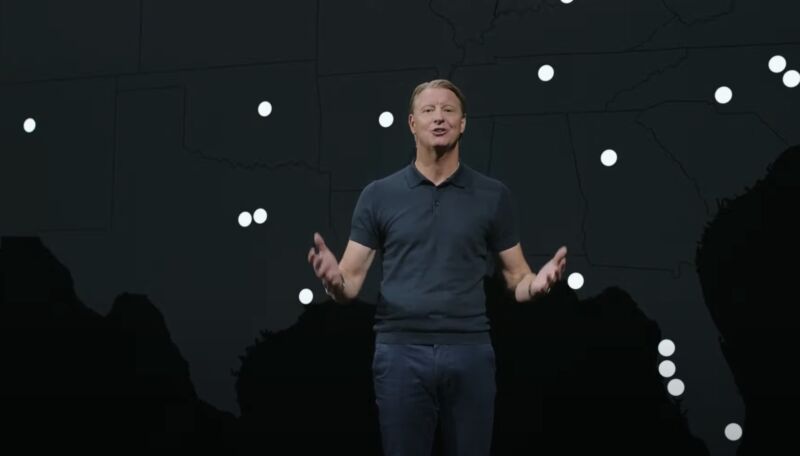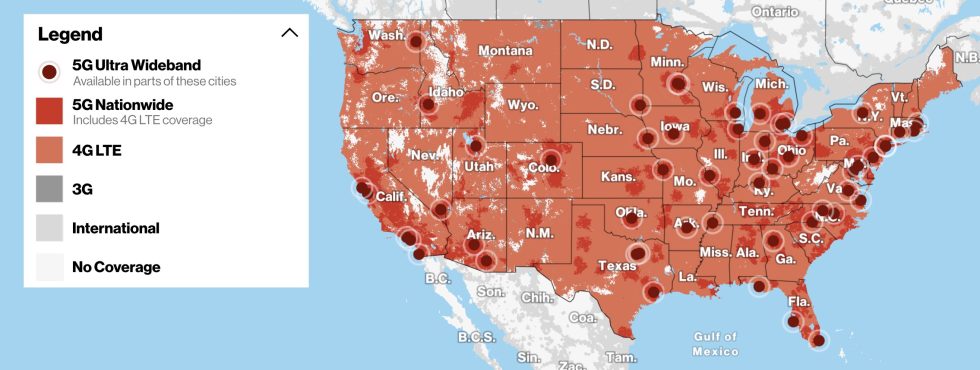
Verizon today announced "nationwide" 5G coverage along with support for the new 5G-enabled iPhones. But for most consumers, Verizon's 5G upgrade won't make much of a difference.
The newly enabled 5G runs on the same spectrum bands used by Verizon for 4G, so it won't be nearly as fast as Verizon's millimeter-wave version of 5G. Verizon CEO Hans Vestberg said in May that 5G users on the non-millimeter-wave bands will see only a "small" upgrade at first.
"Nationwide" doesn't mean it's available everywhere, either. As Verizon said in its announcement today, nationwide means that Verizon 5G "is available today to more than 200 million people in 1,800 cities around the US." That definition satisfies a standard set by the National Advertising Division, which is the advertising industry's self-regulatory body. NAD says that, in general, "a wireless network can claim to be nationwide or coast to coast if the provider offers service in diverse regions of the country and the network covers at least 200 million people."
The standard is over 15 years old and hasn't been updated for increases in US population. Under the 200 million-person standard, carriers can advertise nationwide coverage if their networks reach about 60.5 percent of the country's 330.4 million residents.
Verizon's updated coverage map shows availability of 5G in and around many populated areas, with most of the country's land mass still covered by 4G but not 5G:

Still, coverage of 200 million people is a big increase in scale over Verizon's previous 5G coverage, which is limited to tiny pockets of big cities. Until now, Verizon 5G relied solely on millimeter-wave frequencies that don't travel as far as low- and mid-band radio waves and are easily blocked by walls and other obstacles. Research firm OpenSignal recently found that users of its speed-test app were able to get a Verizon 5G signal just 0.4 percent of the time, compared to 22.5 percent for T-Mobile, 14.1 percent for Sprint, and 10.3 percent for AT&T. (Sprint is now a T-Mobile subsidiary.)
Verizon's 5G availability percentage should go up quite a bit now thanks to its use of low-band spectrum. But Verizon's average download speed of 27.4Mbps (as measured by OpenSignal) shouldn't change much since the big 5G expansion is using the same spectrum as 4G.
Verizon didn’t say how fast the new 5G is
Vestberg appeared with Apple CEO Tim Cook at the iPhone 12 reveal today. Notably, he didn't say anything about what speeds customers can expect on the nationwide 5G. He only talked about speeds available on Verizon's millimeter-wave network, saying that it can now reach 4Gbps download speeds in ideal circumstances and 200Mbps for uploads. Verizon's press release similarly doesn't say what speeds the nationwide 5G will offer.
Verizon also didn't say exactly what spectrum bands it's using for nationwide 5G. A PCMag report today said Verizon's new 5G is using spectrum in the 850MHz, 1700MHz, and 1900MHz bands. We asked Verizon a few questions about speeds and spectrum bands and will update this article if we get a response.
"As there's going to be no additional airwaves in use, you shouldn't expect much better speeds than on 4G," wrote PCMag, which has done extensive network testing. "5G shines when it has big, broad lanes to itself. On the other hand, this lets Verizon manage a transition from 4G to 5G smoothly, and it lets it light up a 5G icon on many people's phones for marketing reasons."
Verizon did say that it's using Dynamic Spectrum Sharing, which "allows 5G service to run simultaneously with 4G LTE on the same spectrum band." That's important for making sure 5G and 4G users both have enough spectrum access.
We'll have to wait for real-world testing to see how much of a difference the 5G upgrade makes. AT&T's 5G was actually slower than AT&T 4G in nearly all cities recently tested by PCMag.
Verizon today also said its millimeter-wave 5G is now available in 55 cities, up from the previous 36. But again, availability is very limited even in cities that have this coverage. A few more cities will be added this year, bringing Verizon's fastest version of 5G to "more than 60 cities" by the end of 2020.
iPhone 12 optimized for 5G
You need a phone that can support 5G to access any of the carriers' 5G networks. Apple today said the iPhone 12 supports more 5G bands than any other smartphone, with all models connecting to both millimeter-wave and sub-6GHz spectrum. The list of specific bands supported by each model is available on Apple's iPhone 12 specs page. Worldwide, the new iPhones support more than 100 carriers.
The new iPhones also use a "smart data mode" that shifts each phone from 5G to LTE when 5G speeds aren't necessary. Apple said this feature saves on battery life while allowing phones to use 5G whenever the speed boost will provide a noticeable difference to the user.
Apple designed custom 5G antennas and radio components, Apple wireless VP Arun Mathias said during the event. "We analyzed our entire software stack from applications down to firmware to take advantage of 5G speeds," Mathias said. "For example, we optimized iOS frameworks so apps can get the benefits of 5G without using more power."
Business - Latest - Google News
October 14, 2020 at 04:52AM
https://ift.tt/33WWWNn
Verizon “nationwide” 5G ready for iPhone 12—don’t expect a big speed boost - Ars Technica
Business - Latest - Google News
https://ift.tt/2Rx7A4Y
Bagikan Berita Ini
















0 Response to "Verizon “nationwide” 5G ready for iPhone 12—don’t expect a big speed boost - Ars Technica"
Post a Comment